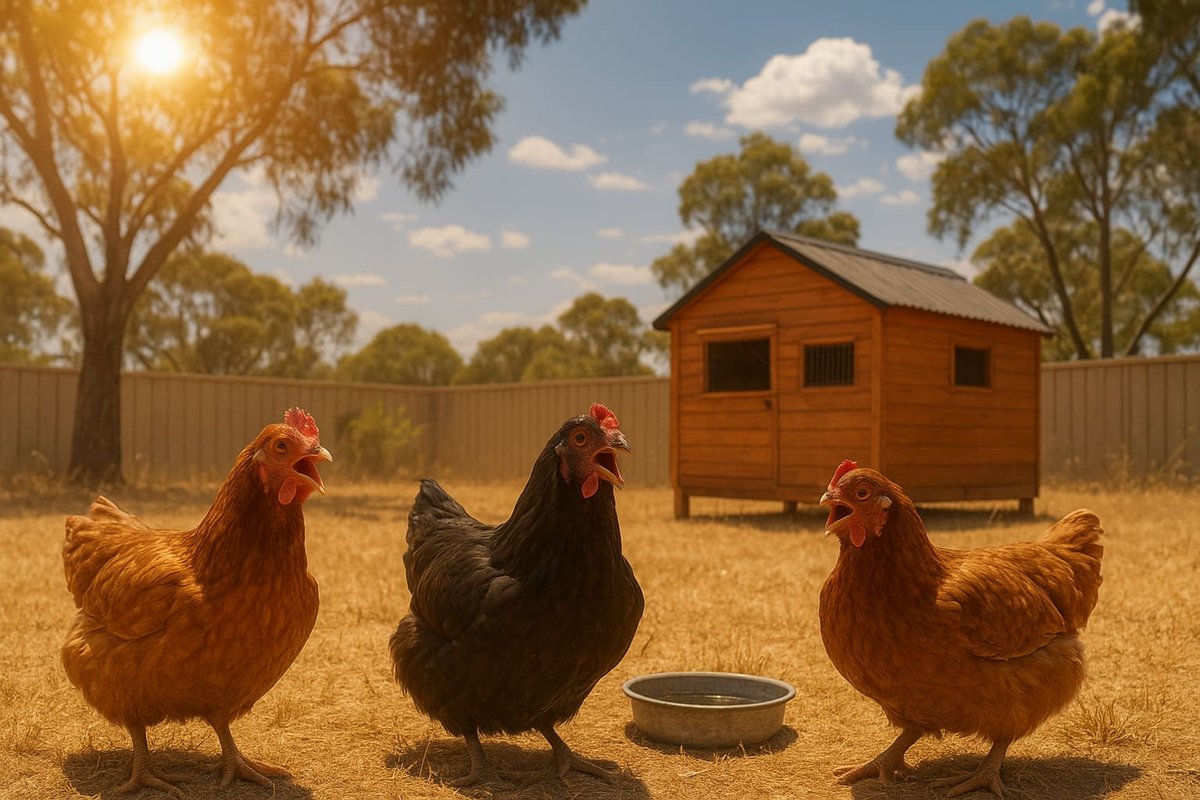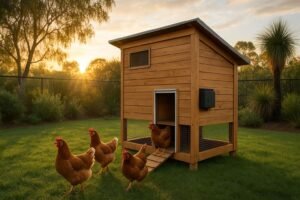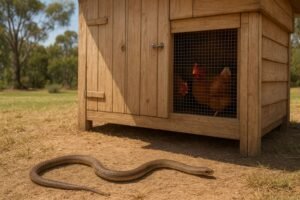G’day! Australian summers are no joke. Whether you’re in a steamy Sydney backyard, a dry Melbourne heatwave, or baking in Perth, those 40°C+ days can be brutal. And for our backyard chooks, it’s not just uncomfortable—it’s-a-deadly.
Seeing your flock panting and struggling is rough. As a backyard keeper in Brisbane, I’ve seen my flock drop eggs during 40°C waves – but these tips fixed it. That’s why knowing how to keep chickens cool in summer in Australia is one of the most important jobs for any chook keeper. High temps don’t just stop your hens from laying; they can cause heat stress and, in the worst cases, death.
But don’t stress! With a bit of planning, you can get your chickens through the hottest days safely.
In this guide, we’ll cover everything. We’ll answer what temperature is too hot for chickens in Celsius, how to keep chickens cool in 100 degree weather (that’s about 38°C), and give you practical, step-by-step tips that actually work.
Let’s dive in and get your flock ready to beat the heat.
Why Do Chooks Struggle So Much with Heat?
Ever wondered why you’re handling the heat (barely) but your chickens look like they’re about to collapse? It’s all about their biology.
Unlike us, chooks have no sweat glands. As academic sources like UNE poultry heat stress research explain, they can’t sweat to cool off. Instead, they have two main methods:
- Panting (Gular Flutter): They pant rapidly to evaporate water from their lungs. This works, but it costs a lot of energy and can lead to dehydration fast.
- Radiating Heat: They spread their wings and send blood to their combs, wattles, and legs. These unfeathered areas act like little radiators to dump heat.
Their feathers are fantastic insulation in winter, but in summer, it’s like wearing a permanent down jacket. This means they rely entirely on us to create a safe environment for them.
Understanding this is the first step, as it shows just how important shade, water, and airflow really are. Now, let’s look at the numbers you need to watch.
How Hot Is Too Hot Outside for Chickens? (What Temperature Is Too Hot for Chickens in Celsius?)
This is the first question everyone asks. It’s important to know the danger zones, because chooks are tougher than they look… until they’re not.
Their ideal temperature is actually between 18°C and 29°C. Once the thermometer climbs past that, they start working to stay comfortable.
Here’s a simple breakdown of what your chooks feel:
- 29°C – 32°C: This is the ‘uh oh’ point. You’ll start to see mild signs of heat stress, like light panting and holding their wings out. They’re uncomfortable, but managing.
- 32°C – 37°C: Now they’re definitely struggling. Panting will get faster and more obvious, and they’ll look lethargic. Egg laying will probably slow down or stop. This is high-stress.
- 37°C+: This is the DANGER ZONE. Severe heat stress sets in. At this point, their panting can’t keep up, and their internal body temperature starts to rise, which can lead to organ failure. The risk of death is high, especially if it’s also humid (hello, Queensland!), a fact backed by DAFF poultry biosecurity standards.
So, what temperature is too hot for chickens in Celsius? Anything over 30°C is cause for concern, and anything over 37°C is an emergency, per DAFF 2025-aligned guidelines.
“But how hot of temperature can chickens tolerate?” you might ask. They can survive short bursts over 40°C, but only if they have deep shade, lots of refreshing water, and good airflow. Don’t risk it.
Here’s a quick conversion chart since we often hear American temps in guides:
| Fahrenheit | Celsius | What it means for your chooks |
|---|---|---|
| 85°F | 29°C | Starting to feel the heat. |
| 90°F | 32°C | Mild heat stress. Take action. |
| 95°F | 35°C | Serious stress. Egg-laying drops. |
| 100°F | 38°C | DANGER ZONE. High risk. |
| 105°F | 41°C | Extreme danger. |
| 110°F | 43°C | Deadly. |
Knowing the danger zones is one thing, but spotting a chook in trouble is the next vital skill.
What Do Chickens Do If They’re Too Hot? Signs of Heat Stress
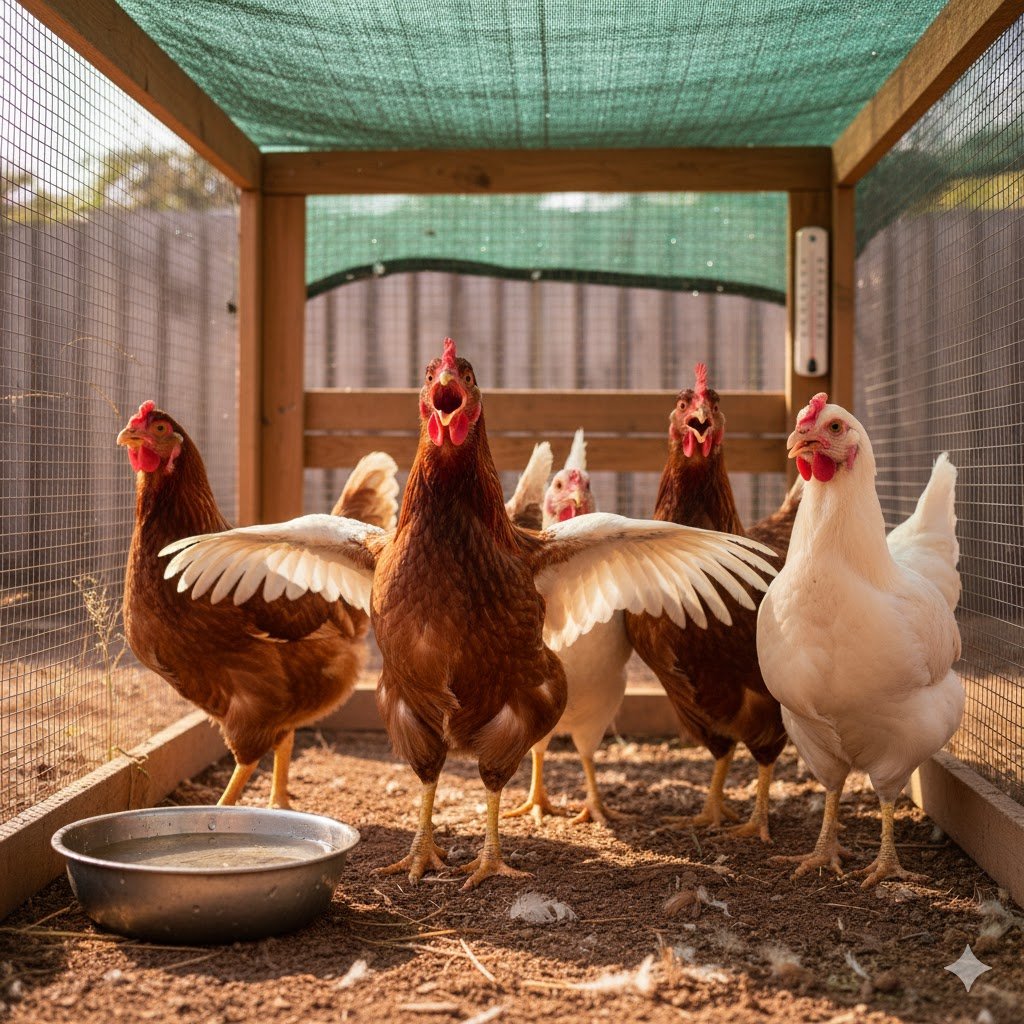
Your chooks can’t tell you they’re struggling, so you need to be a ‘heat detective’. Look for these 8 common signs of heat stress in chickens. The earlier you spot them, the easier it is to help.
- Panting or Gaping: This is the most obvious sign. They’ll have their beaks open, breathing fast. This uses up a lot of energy and water, leading to dehydration.
- Holding Wings Out: They’ll spread their wings away from their bodies. This ‘wing-spreading’ lifts their feathers to let any small breeze get to their skin and helps radiate heat.
- Lethargy: They’ll stop moving, scratching, or foraging. They might just stand or sit limply in the shade. Healthy chooks are busy; a still chook is often a sick or stressed chook.
- Pale Comb and Wattles: Their bright red combs and wattles (their ‘radiators’) might look pale or even purplish. This is a sign their circulatory system is struggling.
- Loss of Appetite: They’ll stop eating or drinking. This is very dangerous, as it leads to dehydration fast.
- Runny Droppings: You might notice watery diarrhoea as their body tries to cope and flush heat.
- Laying Stops: Their bodies shut down non-essential tasks, like making eggs. We’ll cover this more later.
- Stumbling or Seizures: This is a critical sign of advanced heat stroke. They might look ‘drunk’, stagger, lie on their side, or collapse. You must act immediately.
So, what do chickens do if they’re too hot? They pant, spread their wings, and stop moving. If your chooks are panting, what should you do? Read on for the immediate first aid steps.
Heat Stress vs. Heat Stroke: What to Do Right Now
It’s crucial to know the difference.
- Heat Stress = Signs 1-7. The chicken is coping, but needs help.
- Heat Stroke = Sign 8. The chicken’s body is failing. This is an emergency.
If you see signs of HEAT STRESS (panting, wings out, lethargy):
- Don’t panic. Gently encourage them into a shadier spot.
- Make sure they have fresh, refreshing water. Bring the water to them if you have to.
- Turn on a mister or fan if you have one.
- Offer some chilling treats like frozen watermelon or peas.
If you see signs of HEAT STROKE (stumbling, collapse, seizures):
This is an emergency. Follow the steps from authorities like the NSW DPI heat stress guide.
- Move them NOW. Gently pick the chicken up and bring her inside to a shady spot like the laundry or a bathroom.
- Cool her down. Get a tub or bucket of cool water, not ice-cold. Ice water can cause shock.
- Stand her in it. Place the chicken in the water so her feet and legs are submerged. This cools her down fast. You can gently splash refreshing water onto her comb and wattles.
- DO NOT submerge her whole body or head. This can cause shock or drowning.
- Keep her inside in the calm, quiet area with water until she is back to normal.
Acting fast can save a life. But the best ‘treatment’ is always prevention.
How to Keep Chickens Cool in Summer (Your 8-Step Australian Survival Plan)
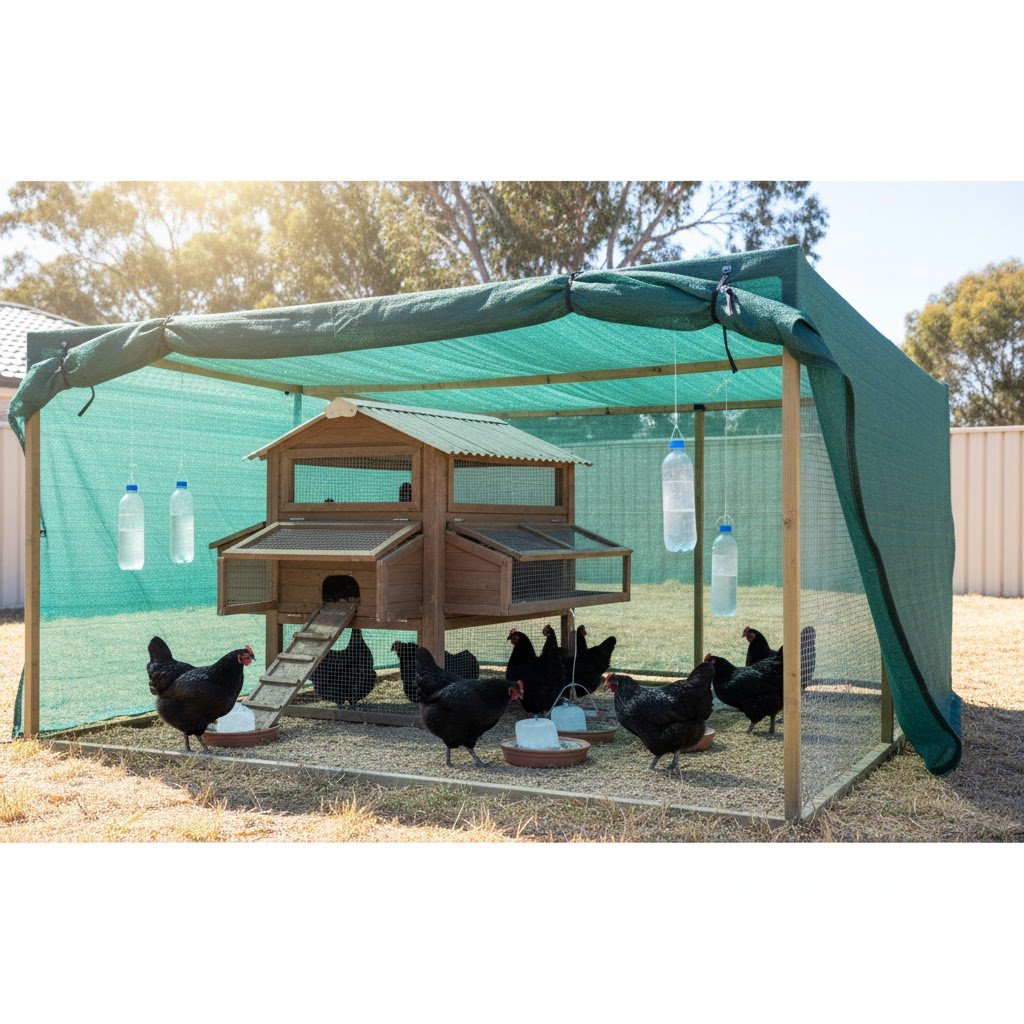
The best plan is prevention. Here are 8 proven ways to prepare your coop and run for an Aussie summer, expanded in detail. These poultry cooling methods for Australia are your foundation for a safe summer.
1. Shade is King (and Not All Shade is Equal)
This is non-negotiable. Your chooks must have a place to get out of the direct sun all day long.
- Natural Shade: Trees and large shrubs are the best. They not only block the sun, but they also lower the temperature of the air around them (it’s called transpiration!). A big, leafy tree is nature’s air-conditioner.
- Built Shade: If you don’t have trees, you must build shade.
- Shade Cloth: This is a classic for a reason. Get a high-rated (70-90%) shade cloth and stretch it over the run. Crucially, leave a big gap between the cloth and the run’s roof. You need airflow, otherwise you’re just trapping hot air, a tip backed by resources like The Poultry Site.
- Solid Roof: A solid, light-coloured metal or poly roof is even better, as it also keeps the rain off. Again, make sure it’s high up to allow breezes.
2. The Secret to Cool Water (More is More!)
One waterer isn’t enough. When it’s 40°C, a chook can drink up to a litre of water.
- Multiple Stations: Put out at least 2-3 waterers, and make sure they are all in the shade, all day long. A waterer that gets hit by the afternoon sun will be too hot to drink.
- Add Ice: This is the oldest trick in the book. Add big ice blocks (from old takeaway containers or ice cream tubs) to the water in the morning.
- Pro-Tip (Material Matters): Plastic waterers get hot fast. If you can, use wide, shallow ceramic or metal bowls in the shade. The water stays chilled for longer.
3. Boost Your Coop’s Ventilation (The “Chimney Effect”)
This is the big one everyone gets wrong. A stuffy coop is a death trap. You need airflow.
- What is Good Ventilation? You need vents down low (for fresh air to come in) and vents up high (for hot air to escape). This creates a natural “chimney effect” that pulls air through the coop.
- Action: Make sure your coop has big windows or vents (covered with 10mm x 10mm wire mesh to keep pests out). Open everything up on hot days and hot nights. Airflow is critical.
4. Rethink Your Coop Design and Location
Is your coop a tiny hotbox? Now’s the time to fix it.
- Colour: Is your coop painted a dark colour? Paint it white or a very light colour. This reflects sunlight and can drop the internal temp by several degrees.
- Roof: A metal roof with no insulation is an oven. If you have one, paint it white and consider adding a layer of insulation (like builder’s silver-backed foil) underneath.
- Orientation: Where is your coop facing? If the big solid wall faces west, it’s getting smashed by the hottest arvo sun. If possible, orient the coop so the smallest side faces west. Planting a fast-growing deciduous tree to shade that west wall is a perfect long-term plan.
5. Smart Summer Feeding (And Cooling Treats)
Did you know digestion creates body heat?
- Change Your Feed: Avoid giving lots of “scratch mix” or cracked corn in summer. These high-carb feeds make the chooks work harder to digest, which adds to their body heat. (It’s great for winter, terrible for summer).
- Change Your Timing: Feed your chooks their main meal in the late evening or very early morning when it’s less hot. They’ll be more likely to eat, and they won’t be digesting in the heat of the day.
- Frozen Treats: This is their favourite tip! Give them frozen peas, corn, or watermelon in the afternoon. It helps them chill out, rehydrates them, and gives them something to do.
6. Choose the Right Chooks (Heat-Hardy Breeds)
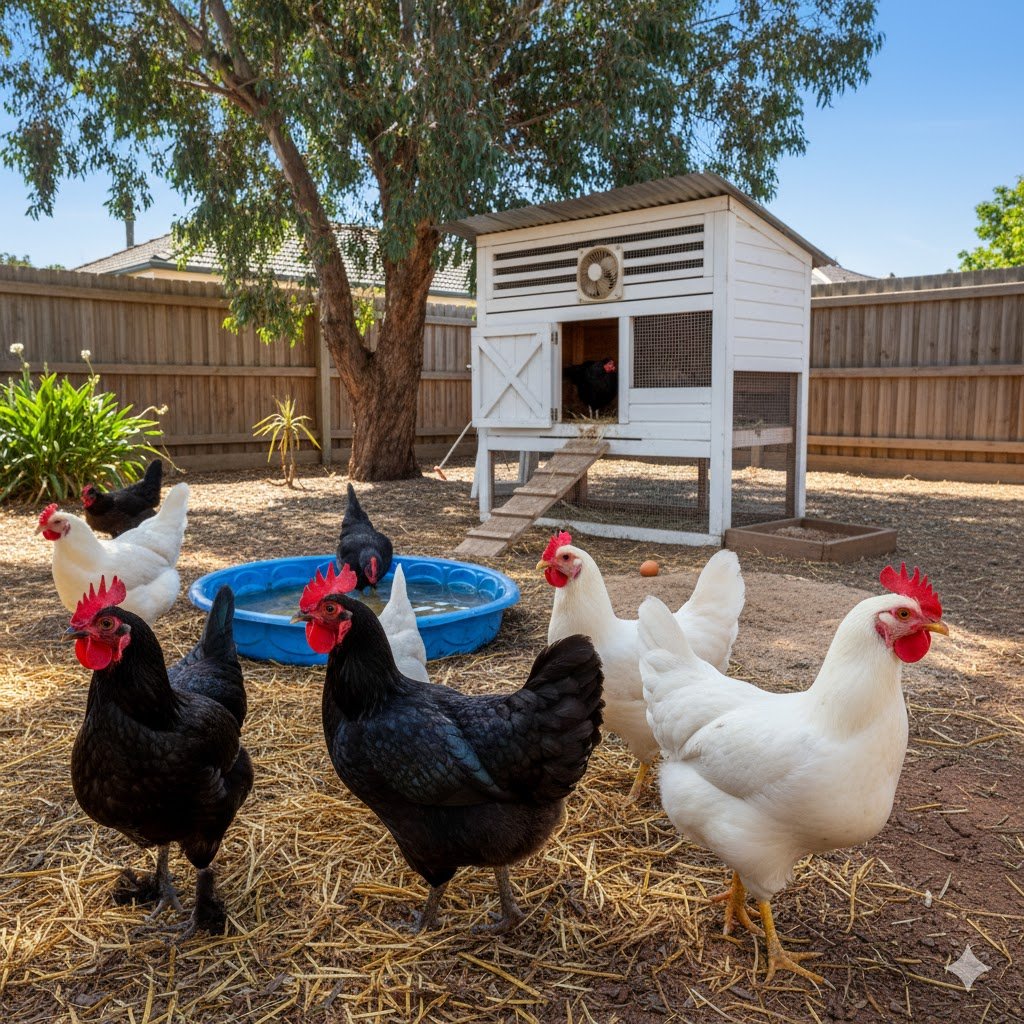
This is a massive factor. Some breeds are built for heat, others are built for snow.
- Best Breeds for Aussie Heat: Look for breeds with large combs and wattles (their ‘radiators’) and lighter bodies.
- Leghorns: The champions. Light, active, big combs.
- Australorps: Our Aussie superstars! They are a bit heavier but were bred here and are very resilient, as noted by Poultry Hub Australia.
- Rhode Island Reds: A great all-rounder that handles both heat and cold well. Per Omlet 2025, Rhode Island Reds are top for warm Aussie climates.
- Minorcas & Hamburgs: Other Mediterranean breeds built for warmth.
- Worst Breeds for Aussie Heat: Avoid the big, fluffy, ‘cold-hardy’ breeds.
- Orpingtons, Wyandottes, Brahmas, Sussex. If it’s described as “fluffy” or “cuddly,” it’s going to struggle.
7. Offer a “Kiddie Pool” (Safely!)
We’ll cover this more later, but a shallow pan of water for them to wade in is a lifesaver. This cools their feet and legs, which is one of the fastest ways to lower their core temperature.
8. Shady Dust Baths
Chooks need to dust bathe to control mites and lice. But they won’t use a dust bath that’s in the blazing sun. Make sure their favourite dusting spot is shaded, dry, and fluffy.
These 8 steps are your foundation for a safe summer. Get these right, and you’re 90% of the way there.
How to Keep Chickens Cool in 100 Degree Weather (or 110 Degrees – Extreme Heatwaves)

Okay, now for the really bad days. When the forecast says it’s hitting 38°C (100°F) or even 43°C (110°F), you need to step up your game. This is “all hands on deck” and your plan for extreme heat chicken survival. For 110 degrees (43°C), monitor every hour – this is critical.
- Add Electrolytes: On these horror days, your chooks are losing salts through panting. Add poultry electrolytes (from a produce store) to their water. In a pinch, a small amount of a non-sugar-free sports drink (like Gatorade) will do. Use it sparingly at about a 1:10 dilution (1 part Gatorade to 10 parts water).
- Get the Misters Out: We’ll talk more about misters for chickens soon, but on these days, they are a huge help. A fine mist can drop the air temp in their run by 5-10 degrees.
- Bring in the Fans: If your coop or run has power, a fan (placed safely where chooks can’t reach it) can create a life-saving breeze. Air movement is more important than just cool air. This is vital for how to keep chickens cool in coop at night.
- “Chook-sicles”: Freeze a mix of their favourite grains, veggies, and seeds in a big ice-cream container of water. Hang it in the shade for them to peck at. This is great enrichment and helps them chill out as they eat.
- Don’t Disturb Them: Leave them alone. Don’t chase them or try to make them move. Let them conserve energy in the shade. Cancel any coop cleaning for that day.
On these days, you’ll also notice a big drop in eggs. Don’t worry, it’s normal.
Will Chickens Lay in Extreme Heat? Impacts on Egg Production
You’re not imagining it. As soon as the thermometer climbs over 30°C, egg production takes a nosedive.
So, will chickens lay in extreme heat? Yes, some will, but you can expect a 20-50% drop in eggs. You might also see eggs that are smaller or have thin, weak shells.
This is because the hen’s body is under serious stress.
- Stress: All her energy is going into just surviving, not making eggs.
- Eating Less: She’s eating less feed, so she has fewer nutrients to make eggs.
- Calcium: Heat stress messes with her ability to process calcium, which is why the shells get thin.
How to help:
- Make sure the nesting boxes are the shadiest, darkest part of the coop.
- Keep them extra hydrated. Eggs are mostly water!
- Accept that you’ll have fewer eggs until the heatwave passes. It’s a normal, healthy response for them.
When it’s this hot, you’ll be tempted to use every tool you have, especially misters and water. Let’s look at the right way to do it.
Misters for Chickens and Other Cooling Materials (What Material Is Used to Cool Off Chickens?)
Let’s talk hardware. Misters for chickens can be great, but you need to use them correctly, especially in Australia.
- Dry Heat (Perth, Melbourne, Adelaide): Misters are fantastic. The fine mist evaporates instantly, “flash cooling” the air. Go for it!
- Humid Heat (Sydney, Brisbane, QLD): Be very careful. In high humidity, the mist doesn’t evaporate. It just makes everything wet. Wet feathers in high humidity trap heat and stop the chooks from cooling. In this case, a fan is much better than a mister.
But what material is used to help chickens chill out? Honestly, the best stuff is cheap or free!
- Frozen Water Bottles: The #1 tip. Freeze 2-litre soft drink or milk jugs full of water. Place these in the coop, in the run, and even right next to their waterer. They’ll lay up against them to beat the heat.
- Ice: Dump ice cubes in their water dishes.
- Frozen Veggies: A handful of frozen peas or corn is the perfect arvo snack.
- Cool Ceramic Tiles: Grab some old tiles, keep them in the shade (or even in the fridge for a bit), and place them in the run. Your chooks will love lying on the refreshing surface.
Using water on them is tricky, but getting them in water is a different story.
Will Chickens Get in Water to Cool Off? Safe Ways to Use Water
You won’t see your chooks doing laps, but they are smarter than we think.
So, will chickens get in water to cool off? Yes! They will happily stand in shallow, refreshing water to cool their feet and legs. This is a very fast way for them to lower their body temperature.
How to do it:
- Get a shallow tub, a paint roller tray, or a ‘kiddie pool’.
- Fill it with just a few centimetres of water. That’s it! Just enough to cover their feet.
- Place it in the deepest shade.
- They’ll walk in, have a drink, and stand there to chill out. It’s a lifesaver. Warning: Never try to ‘help’ by dunking your chicken in a deep bucket of water. The shock can be very dangerous for them. Let them walk in on their own terms.
The heat doesn’t always stop when the sun goes down. Those sticky, 25°C+ nights can be just as dangerous.
Night-Time Survival: How to Keep Chickens Cool in the Coop at Night
Figuring out how to keep chickens cool at night is tough. The coop has been baking all day, and now it’s full of chooks radiating body heat.
First, What Not to Do: The Plastic Wrap Mistake
This question comes up a lot, usually from guides about keeping chickens warm in winter.
Should I wrap my chicken coop in plastic? In an Australian summer: ABSOLUTELY NOT.
Wrapping a coop in plastic will trap heat and humidity. It turns your coop into a deadly sauna. You want the exact opposite: maximum airflow.
The Real Secret: Maximum Airflow
This is the most important part of how to keep chickens cool in coop at night.
- Ventilation is #1: Hot air rises. Make sure you have those vents high up in your coop to let that hot air escape. Keep all windows and vents open (covered with predator-proof mesh, of course).
- Safe Fans: A battery-powered or safely installed electric fan makes a huge difference. Don’t aim it right at their perch, but use it to keep the air in the coop moving.
- Frozen Bottles: Put those 2-litre frozen water bottles inside the coop at dusk. They’ll act like little air-conditioners, lowering the temperature of the air as the chooks roost.
Extra Tricks for Those Sticky Aussie Nights
If you’ve done all the above and it’s still scorching, here are a few extra tricks.
- Exhaust Fans: If you’re handy, installing a small exhaust fan in the roof of your coop can actively pull the hot air out. Solar fans for off-grid coops are a popular trend and a fantastic option if you don’t have mains power, as they’ll run during the day to vent hot air and some models can store power for the evening.
- Evening Ground-Soak: Around the coop (not inside it), give the ground a good hosing down at dusk. As that water evaporates overnight, it will lower the temperature of the air in the immediate area.
- Check Perches: Make sure your chooks have enough space on their perch to spread out. They won’t want to huddle together when it’s hot.
Your Summer Survival Plan
Whew! That’s a lot, but don’t be overwhelmed. You don’t have to do everything at once. Now you’ve got a solid, in-depth plan to protect your flock.
Following these steps on how to keep chickens cool in summer in Australia will make a huge difference to your chooks’ health and happiness. You can’t change the weather, but you can give them the shade, water, and airflow they need to get through it.
Start with the easy things: set up extra shade, put out more water, and get some water bottles in the freezer. Your chooks will thank you for it.
Quick FAQ on How to Keep Chickens Cool in Summer in Australia
Q: How hot is too hot for chickens?
A: Anything over 30°C starts to cause stress. Anything over 37°C is in the danger zone and can be deadly.
Q: How do I keep chickens cool in 110 degrees (43°C)?
A: This is an emergency. Use misters (in dry heat) or fans, provide multiple water sources with ice, offer frozen treats, and ensure deep shade. Move any struggling birds inside a cool room and stand them in refreshing (not icy) water.
Q: What are the first signs of heat stress in chickens?
A: The two easiest signs to spot are panting (holding their beak open) and holding their wings out away from their bodies.
Q: Will my hens stop laying eggs in the heat?
A: Yes, expect egg production to drop. It’s a normal response to heat stress as their bodies conserve energy.
Q: Should I feed chickens corn in summer?
A: It’s better to avoid it. High-carb feeds like corn and scratch mix create extra body heat when digested, making it harder for your chooks to cool down.
Q: What material is used to cool off chickens?
A: Frozen 2-litre water bottles or cool ceramic tiles work best – they are cheap, effective, and your chooks can lean against them.
Q: What’s the best way to keep a coop cool at night?
A: Maximum airflow is the secret. Open all vents and windows (covered with predator-proof mesh) to let hot air escape. You can also use a safe fan to move air and place frozen 2-litre bottles inside the coop.
Conclusion
Well, there you have it. Surviving an Aussie summer with backyard chooks isn’t about fighting the heat—it’s about working with it. By understanding how your chickens cool themselves and providing those simple essentials (shade, water, and airflow), you can make a massive difference to their comfort and safety.
Remember, a little bit of prep goes a long way. Getting your coop ventilated, planning your shady spots, and having a few frozen treats ready to go is 90% of the battle. Your chooks are relying on you to be their “air-conditioning,” and now you’ve got all the tools you need.
So, stay comfortable, keep an eye on your flock, and don’t forget to enjoy the eggs you get on the less sweltering days. Good on ya for being a great chook owner!

Oladepo Babatunde is the founder of ChickenStarter.com. He is a backyard chicken keeper and educator who specializes in helping beginners raise healthy flocks, particularly in warm climates. His expertise comes from years of hands-on experience building coops, treating common chicken ailments, and solving flock management issues. His own happy hens are a testament to his methods, laying 25-30 eggs weekly.
